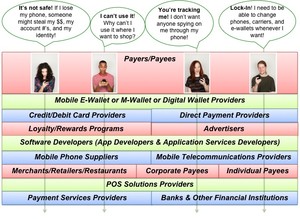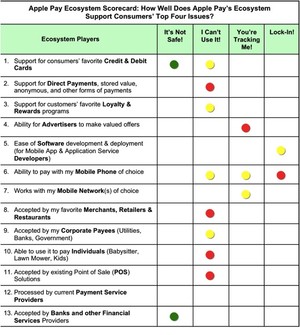We published our initial review of Apple Pay functionality on October 11th. Our conclusions are summarized in this Report Card:
|
Customer’s Moments of Truth for Mobile E-Wallets |
Grade |
|
It’s not safe! Fear of theft of assets, account information getting into the wrong hands, and identity theft. |
B+ |
|
I can’t use it! Inability to pay everywhere I want to shop, using my payment type of choice. |
D |
|
You’re tracking me! Fear of “big brother” or any entity knowing where I am, what I’m doing, and making that information available to others without my knowledge or permission. |
C |
|
Lock-In! Once I start using a mobile e-wallet (assuming it’s safe to do so), how easily can I switch? |
B |
This week we take a deep dive into the entire ecosystem of partners required to support Apple Pay (or any mobile e-wallet). (See How Good Is Apple Pay’s Ecosystem?) We ask the question: How well have the players in the Apple Pay ecosystem aligned to address these four customer-critical issues?
(Click on image to enlarge.)
© 2014 Patricia Seybold Group Inc.
The answers are shown in this chart:
(Click on image to enlarge.)
Apple Pay Is Optimized to Reduce Fraud and Support Banks. The Apple Pay ecosystem is optimized to address consumers’ concerns about credit card and identify theft as well as to eliminate some of the costs born by banks and other financial services providers in the ecosystem—the credit card issuers—by reducing the risk of fraud and the costs of fraud detection and prevention.
Optimizing around the risk of fraud and theft and catering to financial services providers is clearly a studied calculation that Apple’s design and management team made.
Merchants and Retailers Are Not the Design Center of the Apple Pay Ecosystem. If Apple had chosen instead to optimize around ubiquity of payment acceptance, they would have designed a solution that was easier for many more merchants to accept. Such a solution would need to make use of the current installed base of POS devices and provide more cost-effective and safer payment types. A merchant-optimized ecosystem (like MCX CurrentC, which was designed by retailers for retailers) would also enable each merchant to easily capture all the details of each consumer’s transactions and to easily integrate their own loyalty and rewards programs into the shopping and payment experience.
How Would the Apple Pay Ecosystem Look If It Were Truly a Customer Ecosystem?
7 Things the Apple Pay Ecosystem Needs to Change. What would be different if customer experience had really been the design center of the Apple Pay ecosystem? To become a customer ecosystem, Apple Pay should:
- Work with both NFC (Near Field Communications) and non-NFC Point of Sale systems. Both kinds of transactions would require the same level of authentication (e.g., fingerprint and/or personal code).
- Retain the tokenized approach to the payment transaction. Merchants do not need or want to see or to store consumers’ payment details.
- Enable direct payments, e.g., direct-from-bank account payments, stored value payments, merchant-specific payments, loyalty points or rewards payments, as well as anonymous payments (e.g., Bitcoin or equivalent) in addition to supporting both consumer and business credit and debit card payments.
- Enable consumers to associate particular payment types (e.g., specific rewards credit cards or loyalty cards) as the default for particular payees.
- Let consumers combine their brand-specific or retailer-specific loyalty cards with their payment transactions.
- Give consumers control, on a brand-by-brand basis, over which retailers and brands are able to “know” their identity and associate their identity with their specific transactions.
- Let consumers pay one another by transferring value securely from Apple Pay to individuals’ accounts (including people who do not use Apple Pay).
Notice that none of these customer-requirements would be that difficult for Apple and its ecosystem partners to address.
How the Apple Pay Ecosystem Is Likely to Evolve
Bear in mind that a healthy customer ecosystem will “automagically” begin to align to support and mitigate consumers’ top issues. In fact, you see signs of that happening already; now, only one week into actual operation in the U.S., a number of credit card companies, retailers, and banks are now hopping on board. That’s the first wave of response to consumer demand.
The second wave will be more difficult: Many merchants and retailers will continue to try to resist accepting Apple Pay until Apple supports non-credit and debit card transactions, taking the credit-card issuers (and their fees) out of every transaction. Yet Apple also solves a major problem for retailers: it will now be impossible for consumers’ credit card information to be stolen from their in-store point of sale systems and retail systems, because, with Apple Pay, retailers won’t ever have possession of consumers’ credit card information.
Retailers may be underestimating the importance of that peace of mind for their consumers. We predict that many consumers will buy and use Apple iPhones to pay at their stores specifically to increase their security and peace of mind.
Customers Will Reshape the Ecosystem to Meet Their Needs
We predict that customers voting with their feet and their tweets and their wallets will begin to reshape the Apple Pay ecosystem to better address their critical needs. It will be interesting to compare the Apple Pay ecosystem in one to two years to the Apple Pay system at its launch. Stay tuned.
How Good Is Apple Pay’s Ecosystem?
How Well Does Apple Pay’s Ecosystem Meet Consumers’ and Partners’ Critical Needs?
By Patricia B. Seybold, CEO and Sr. Consultant, October 31, 2014





